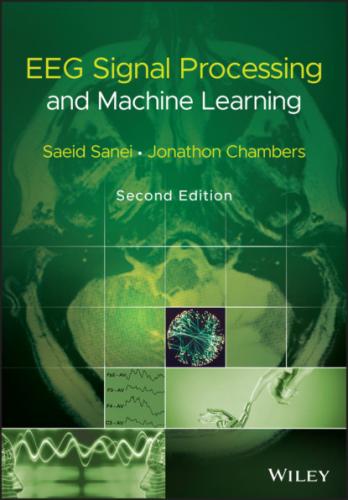and
(3.54)
where χn‐1 contains all the past information up to time n‐1. The original GARCH(p,q) model, where p and q are the prediction orders, considers a zero mean case, i.e. g(.) = 0. If e(n) represents the residual (error) signal using the above nonlinear prediction system, we have:
(3.55)
where αj and βj are the nonlinear model coefficients. The second term (first sum) in the right side corresponds to a qth order moving average (MA) dynamical noise term and the third term (second sum) corresponds to an AR model of order p. It is seen that the current conditional variance of the residual at time sample n depends on both its previous sample values and previous variances.
Although in many practical applications such as forecasting of stock prices the orders p and q are set to small fixed values such as (p,q) = (1,1); for a more accurate modelling of natural signals such as EEGs the orders have to be determined mathematically. The prediction coefficients for various GARCH models or even the nonlinear functions g and h are estimated iteratively as for the linear ARMA models [36, 37].
Such simple GARCH models are only suitable for multiplicative nonlinear dependence. In addition, additive dependencies can be captured by extending the modelling approach to the class of GARCH‐M models [40].
Another limitation of the above simple GARCH model is failing to accommodate sign asymmetries. This is because the squared residual is used in the update equations. Moreover, the model cannot cope with rapid transitions such as spikes. Considering these shortcomings, numerous extensions to the GARCH model have been proposed. For example, the model has been extended and refined to include the asymmetric effects of positive and negative jumps such as the exponential GARCH model EGARCH [41], the GJR‐GARCH model [42], the threshold GARCH model (TGARCH) [43], the asymmetric power GARCH model APGARCH [44], and quadratic GARCH model QGARCH [45].
In these models different functions for g(.) and h(.) in (3.48) and (3.49) are defined. For example, in the EGARCH model proposed by Glosten et al. [41] h(n) is iteratively computed as:
(3.56)
where b, α 1, α 2, and κ are constants and ηn is an indicator function that is zero when un is negative and one otherwise.
Despite modelling the signals, the GARCH approach has many other applications. In some recent works [46] the concept of GARCH modelling of covariance is combined with Kalman filtering to provide a more flexible model with respect to space and time for solving the inverse problem. There are several alternatives for solution to the inverse problem. Many approaches fall into the category of constrained least‐squares methods employing Tikhonov regularization [47]. Among numerous possible choices for the GARCH dynamics, the EGARCH model [41] has been used to estimate the variance parameter of the Kalman filter iteratively.
Nonlinear models have not been used for EEG processing. To enable use of these models the parameters and even the order should be adapted to the EEG properties. Also, such a model should incorporate the changes in the brain signals due to abnormalities and onset of diseases.
3.4.3 Gaussian Mixture Model
In this very popular modelling approach the signals are characterized using the parameters of their distributions. The distributions in terms of probability density functions are sum of a number of Gaussian functions with different variances which are weighted and delayed differently [48]. The overall distribution subject to a set of K Gaussian components is defined as:
(3.57)
The vector of unknown parameters θk = [wk , μk , σk ] for k = 1,2, …, K. wk is equivalent to the probability (weighting) that the data sample is generated by the kth mixture component density subject to:
(3.58)
μk , and σk are mean and variances of the kth Gaussian distribution and p(x| μk , σk ) is a Gaussian function of x with parameters μk , and σk . Expectation maximization (EM) [49] is often used to estimate the above parameters by maximizing the log‐likelihood of the mixture of Gaussian (MOG) for an N‐sample data defined as:
(3.59)
The EM algorithm alternates between updating the posterior probabilities used for generating each data sample by the kth mixture component (in a so‐called E‐step) as:
(3.60)
and weighted maximum likelihood updates of the parameters of each mixture component (in a so‐called M‐step) as:
(3.61)
(3.62)
(3.63)
The EM algorithm (especially in cases of high‐dimensional multivariate Gaussian mixtures) may converge to spurious solutions when there are singularities in the log‐likelihood function due to small sample sizes, outliers, repeated data points or rank deficiencies leading to ‘variance collapse’. Some solutions to these shortcomings have been provided by many researchers such as those in [50–52]. Figure 3.13 demonstrates how an unknown multimodal distribution can be estimated using weighted sum of Gaussians with different mean and variances:
Figure 3.13 Mixture of Gaussian (dotted curves) models of a multimodal unknown distribution (bold curve).
Similar to prediction‐based models, the model order can be estimated using Akaike information criterion (AIC) or by iteratively minimizing the error for best model order. Also, mixture of exponential distributions can also be used instead of MOGs where there are sharp transients within the data. In [53] it has been shown that these models can be used for modelling variety of physiological data such as EEG, EOG, EMG, and ECG. In another work [54], the MOG model has been used for segmentation of magnetic resonance brain images. As a variant of the Gaussian mixture model (GMM), Bayesian GMMs have been used for partial amplitude synchronization detection in brain EEG signals [55]. This work introduces a method to detect subsets of synchronized channels
